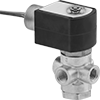Filter by
For Use With
Valve Position
Body Material
Maximum Pressure @ Temperature
Actuation
Valve Function
Environment
Mounting Position
Fitting Connection
Wire Connection
Actuator Housing Material
DFARS Specialty Metals
About Actuated On/Off Valves
More



























































